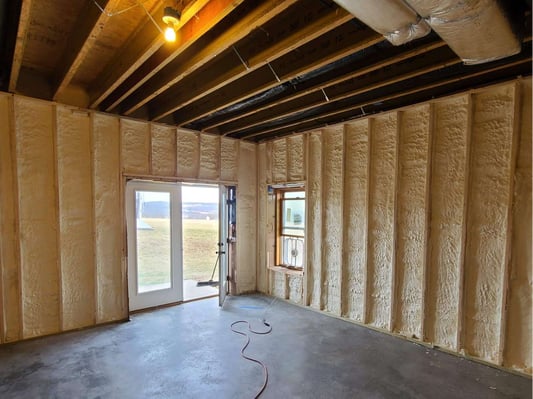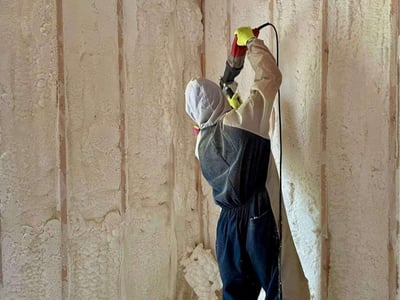Are There Tax Incentives For Spray Foam Insulation?
September 11th, 2023
4 min read

You’re interested in spray foam insulation for your project. The high-performance results of better air quality, more comfort, and lower energy bills have you sold. The only issue is the price tag. You know spray foam is an investment that will pay for itself, but you’re hoping there are some tax breaks you can enjoy for the cost of spray foam.
South Central Services has installed spray foam in hundreds of projects. We know that spray foam is a premium product with a high price tag, so anytime customers can save money on it, we want to help them. And the good new is, there are tax incentives available for spray foam.
By the end of this article, you will know:
- What tax credits exist for spray foam insulation
- If there are tax credits for other energy efficiency upgrades
- How tax credits work
- Additional rebates you could take advantage of for energy efficiency upgrades
Don't have time to read right now? Check out everything you need to know at a glance.
Are There Tax Credits For Spray Foam Insulation?
The Inflation Reduction Act of 2022 includes a tax incentive program for energy efficiency upgrades that will run until 2032.
Through this federal program, homeowners can receive money back through taxes for making home improvements. This program is relevant for our customers around Greencastle, Pennsylvania and all across the country.
The credits for insulation are 30% of a project cost, up to $1,200.
Therefore, the maximum amount you can spend on insulation upgrades and still benefit from this tax credit is $4,000.
A $4,000 insulation upgrade project will give you $1,200 back through the tax credit.
What Can I Insulate With Spray Foam For $4,000?
What are some home improvement projects that would cost around $4,000 to spray foam? There are numerous spray foam projects that can maximize the tax credit.
Let’s examine some sample estimates for each of these examples to give you an idea of what may be possible.
- A small roof
- A large basement
- Some exterior walls
What’s Considered A Small Roof?
A small roof, insulated with open cell spray foam, may cost about $5,000. Open cell spray foam costs between $0.25 and $0.75 per board foot. For roofs, open cell spray foam needs to be sprayed at a depth of 7 to 12 inches.
 A roof that is 20 feet wide, 30 feet long, 6 feet tall, and has a rake of 15 feet would have an average cost of $5,000 and a highest cost of about $9,000.
A roof that is 20 feet wide, 30 feet long, 6 feet tall, and has a rake of 15 feet would have an average cost of $5,000 and a highest cost of about $9,000.
If you're unsure whether you need insulation in the inside of your roof, see our article to diagnose if your attic needs insulation.
You can calculate an estimate for your own attic using our guide.
What’s Considered A Large Basement?
A large basement, insulated with closed cell spray foam, may cost about $3,000. Closed cell spray foam costs between $1.15 and $1.75 per board foot. For basements, closed cell spray foam is the only option, sprayed at a depth between 2 and 3 inches.

A basement that is 8 feet tall, 15 feet wide, and 30 feet long would have a maximum cost of about $3,700.
You can calculate an estimate for your own basement using our guide.
How Many Exterior Walls Could I Insulate?
You can insulate many exterior walls for $4,000. The average cost to insulate a 10-foot by 10-foot exterior wall is about $450 for closed cell and $225 for open cell spray foam.
You could insulate nearly 9 of these walls with closed cell foam, or almost 18 with open cell foam.
Are There Tax Credits For Other Home Energy Improvements?
This federal program also includes tax credits for many other home energy efficiency improvements. Some examples include:
- Air conditioners
- Furnaces
- Water heaters
- Windows and doors
- Solar energy systems
- Home energy audits
Some of these categories offer more savings than others. If you are deciding which home energy improvement to make, compare the options to find the most cost-effective option for your home.
How Do Tax Credits Work?
These tax credits are a tax break you can receive on your income tax. The contractors or professionals who you work with will not give you a discount. Instead, you will see the savings when you file your taxes for the year.
Tax credits do not automatically populate. When you file your taxes, you must have the receipt for your insulation upgrade. If you work with a tax professional, provide the receipt to them and let them know you’d like to apply for this tax credit.
Either you or your tax professional will fill out the appropriate tax return form to submit with your tax returns.
Other Ways To Save Money With Energy Efficiency Upgrades
The federal government program is the only one that applies to all readers from the United States. Other programs may vary by state or local government. However, we have yet to find state-specific insulation or energy efficiency upgrade programs in our Pennsylvania, Maryland, Virginia, and West Virginia service areas.
Rather than looking for more government rebates, consider looking for rebates from your utility company. If you check your gas or electric bill for your provider, you can look up their website for rebate information. Many power companies offer rebates you can apply for with approved appliance upgrades.
The Bottom Line About Insulation And Tax Incentives
Spray foam insulation is expensive, so any way you can save money is worth looking into. If your project would cost at or around $4,000 to insulate with spray foam, you can get the most return on your investment regarding the tax credit.
You can also find federal tax incentives for other upgrades through the same program, or check your power companies for rebate programs.
Now that you know how much you can save on spray foam insulation through the federal tax credit, your next step is to:
- Learn more about how to use tax credit savings this year
- Discover if spray foam insulation can increase your resale value
- Find out how much spray foam could lower your energy bills
Disclaimer: While we strive to publish information accurate to building science, local building codes and standards supersede our recommendations.
Alexis has been fascinated by spray foam insulation since 2018. When she isn’t thinking about insulation, Alexis is geeking out over storytelling and spreadsheets.
Topics:


